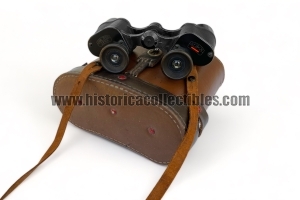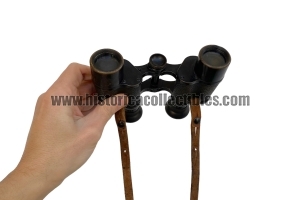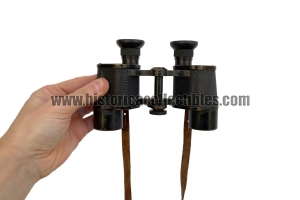Doppelfernrohr 8x26 (Militärmodell), Carl Zeiss Jena, 1914
Doppelfernrohr D.F. 8x26, produced in 1914 by Carl Zeiss Jena, with serial number 372XXX, in a bunch of 300 specimens: in fact it was made in just 400 specimens in total divided into 2 different production bunches (one of 100 and one of 300) between 1913 and 1914.
These binoculars can be recognized by the longer objective barrels and the well-crafted and more robust rib of the eyepiece plates compared to more common ones.
Furthermore, the body of the binoculars has the military acceptance mark "K" imprinted on it, which means that it has passed all the checks and has been accepted by the Gewehr-Prüfungscommission in Spandau.
These exceptional binoculars show on the right eyepiece plate, in addition to the serial number, also the magnifications "D.F. 8x26" which places them as part of a limited production series which considered the relationship between magnifications and diameter of the ocular lenses in a completely particular.
In fact, in those years, Zeiss produced some models with ocular lenses that were not entirely "standard": this was probably an experiment applied in the field which was aimed at achieving a completely optimal supply of vision to the observer, furthermore Zeiss attempted to catch up with its rival Goerz, which at the time already had military models with the same dimensions in its range.
This model is not known in the German Zeiss catalogs and to date only a few surviving examples are known.
Vision is good and perfectly collimated. All mechanisms work correctly and is accompanied by its original case.
Carl Zeiss takes its name from its founder, Carl Zeiss, who on November 17, 1846 chose the small city of Jena, in Thuringia, as the location for his precision optical equipment factory. Thanks to the strict quality control that Carl Zeiss imposed on its products, going so far as to personally destroy the microscopes that did not pass the tests, the newborn Zeiss became the official supplier of the University of Jena and received the gold medal of the industrial exhibition in 1861 of Thuringia as the best research instrument manufactured in Germany, awarded to the microscope Stand I of 1857.
In 1866, the thousandth microscope was produced and the Zeiss name became known in all European scientific circles. Thanks to the studies on the Porro prism, in 1893 Abbe patented a double prism binoculars, which accentuated the perception of depth.
The mass production of Zeiss binoculars began in 1894, already at the beginning of the twentieth century more than 30,000 were made, by the beginning of the First World War the figure had risen to 500,000 and, by the end of the Second World War, 2,260,000 were produced binoculars for the civilian and military market. Models were made starting from 4x11 mm to 12x40 mm, up to real giants such as 80 mm and 100 mm.
Thanks to studies conducted on the perception of light in low light situations, it was shown that the average dilation of the pupil in an adult is about 7 mm. For this reason, the 7x50 mm model was introduced in 1910 and remained on the market until 1917 with few changes to the materials used.
In 1926, following the post-war crisis of the First World War with the Treaty of Versailles which bankrupted many important German companies, Zeiss bought the "C.P. GOERZ" and founded the Zeiss Ikon in 1926.
In 1937, Zeiss had commercial contacts and factories spread over 29 countries around the world. From 1933 Zeiss acquired interest from the Nazi regime, which balanced production towards military instruments. It successfully produced binoculars with wide-angle optics for military use, pressure resistant optical systems for U-boats, periscope binoculars for targeting tanks. Furthermore Zeiss cameras were mounted on the V2 for remote sensing operations of the English coasts.
On November 1, 1935, Zeiss, in the person of Alexander Smakula, patented a process for the treatment of optical glasses with extraordinary results in terms of light transmission. Remained a military secret until 1939, it was adopted on binoculars to reduce ghost images and internal reflections. During the Second World War, there were numerous bombings against the Zeiss factories.
Jena was bombed several times by the Allies starting in 1944. Stuttgart was razed to the ground, although the Contessa-Nettel factory suffered little damage. The bombing of Dresden, in addition to devastating the city, also caused considerable damage to the Zeiss Ikon headquarters.
On April 13, 1945, American military forces entered Jena, surprising themselves as the bombings had not caused significant damage. The main planetarium was in ruins, while the factories remained operational.



